 What To Know Before Buying a New Home?
What To Know Before Buying a New Home?
You need to make a lot of decisions in your life and one of the most important ones is when you are buying you ...
 Unlocking Financial Clarity: The Benefits Of Using A Mortgage Calculator
Unlocking Financial Clarity: The Benefits Of Using A Mortgage Calculator
Purchasing a home marks an exciting milestone in life, often accompanied by many financial decisions. Among th ...
